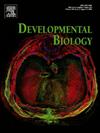规范和LIMK介导的非规范BMP信号的相互作用对调节鸡前脑顶板形态发生过程中的差异厚度和内陷至关重要。
IF 2.5
3区 生物学
Q2 DEVELOPMENTAL BIOLOGY
引用次数: 0
摘要
远端脑半球的形成是一个复杂而精确的时间过程,它开始于鸡前脑顶板中间的内陷。然而,决定内陷在顶板的位置/部位的因素仍有待阐明。在这项研究中,我们已经证明,随着发育的进行,一个较低厚度的区域出现在屋顶板的中间,这标志着内陷开始的位置。我们的研究表明BMP信号的规范(依赖于pSMAD 1/5/9)和非规范(依赖于LIMK)臂之间在调节这一过程中存在相互作用。我们已经证明,依赖LIMK的非规范BMP信号传导在顶板中间诱导高水平的磷酸化Cofilin (pCofilin),这反过来改变了肌动蛋白细胞骨架动力学,导致该区域比外侧区域更薄。这项研究首次提供了前脑顶板内陷的机制,并阐明了BMP信号在这一过程中所起的作用。本文章由计算机程序翻译,如有差异,请以英文原文为准。
Interplay of canonical and LIMK mediated non-canonical BMP signaling is essential for regulating differential thickness and invagination during chick forebrain roof plate morphogenesis
Telencephalic hemisphere formation is a complex and precisely timed process, which begins in the chick forebrain with an invagination in the middle of the roof plate. However, the factor(s) that determine the position/site of invagination in the roof plate remain to be elucidated. In this study, we have demonstrated that as development proceeds, a region of lower thickness appears in the middle of the roof plate, which marks the position where the invagination begins. Our investigations have implicated an interplay between the canonical (pSMAD 1/5/9 dependent) and the non-canonical (LIMK dependent) arms of BMP signaling in regulating this process. We have demonstrated that LIMK dependent non-canonical BMP signaling induces high levels of phosphorylated Cofilin (pCofilin) in the middle of the roof plate, which in turn alters Actin cytoskeleton dynamics, resulting in this region being thinner than the lateral regions. This study has provided the first mechanistic insight into how forebrain roof plate invagination begins and has thrown light on the role played by BMP signaling in this process.
求助全文
通过发布文献求助,成功后即可免费获取论文全文。
去求助
来源期刊

Developmental biology
生物-发育生物学
CiteScore
5.30
自引率
3.70%
发文量
182
审稿时长
1.5 months
期刊介绍:
Developmental Biology (DB) publishes original research on mechanisms of development, differentiation, and growth in animals and plants at the molecular, cellular, genetic and evolutionary levels. Areas of particular emphasis include transcriptional control mechanisms, embryonic patterning, cell-cell interactions, growth factors and signal transduction, and regulatory hierarchies in developing plants and animals.
 求助内容:
求助内容: 应助结果提醒方式:
应助结果提醒方式:


